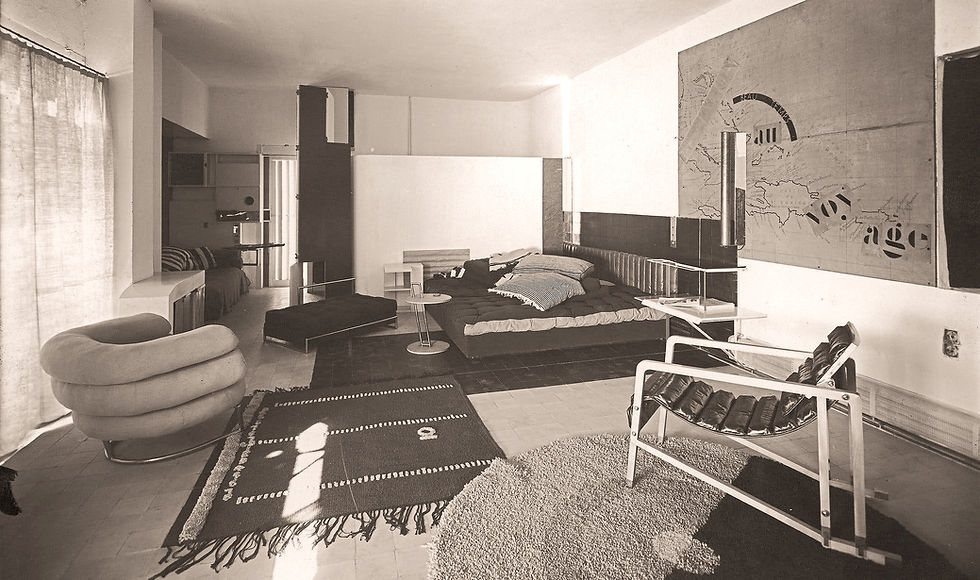Eileen Gray - A Visionary in Design and Architecture
- ARDENT-SPACE

- Aug 14
- 3 min read
Updated: Sep 18
Privileged Beginnings and Early Education
Born Kathleen Eileen Moray Smith into an aristocratic family in Enniscorthy, County Wexford, Gray was the youngest of five children. Her privileged background afforded her access to a refined education and exposure to the arts from an early age. Her father, James McLaren Smith, was a Scottish landscape painter; her mother, Eveleen Pounden, became the Baroness Gray after inheriting the title from her family line. Eileen grew up between Ireland and London, where she was presented at Buckingham Palace in 1898.Educated by governesses and in private schools, she studied at the Slade School of Fine Art in London (1900–1902) before moving to Paris to attend the Académie Colarossi and Académie Julian, immersing herself in the avant-garde artistic and design movements of the time. There she apprenticed with Japanese lacquer master Seizo Sugawara, mastering a craft that would define her early career.
Philosophy and Critical Thinking
Eileen Gray was renowned not just for her talent but for her critical independence of mind. She did not passively follow design trends; she interrogated them. Her oft-quoted maxim,
“To create, one must first question everything.”
was both a personal creed and a challenge to the design orthodoxy of her day.
In contrast to the rigid functionalism of some modernists, Gray emphasized the human experience. Her response to Le Corbusier’s “machine for living” concept was clear:
“A house is not a machine to live in. It is the shell of man, his extension, his release, his spiritual emanation.”
These words positioned her as a designer who sought not only technical perfection but also emotional resonance in her work. She valued the integration of furniture, architecture, and interior details into a
“homogeneous whole built for man, to human scale, and balanced in all its parts.”
Personal Life and Relationships
Gray was famously private about her personal relationships, though she maintained close professional and personal ties with figures in the avant-garde, including the Romanian architect and critic Jean Badovici. Their collaboration resulted in one of her most famous works—Villa E-1027.
Emergence as a Designer
By the 1910s, Gray first gained prominence as a lacquer artist, opened a studio in Paris, catering to wealthy clients. creating richly finished screens and furniture. She became known for her innovative Art Deco pieces – most famously the Dragons Armchair (c. 1917–1919). Over time, she embraced the emerging modernist aesthetic, applying her design skills to interiors, tubular-steel furniture, and architecture. By the 1920s, she had transitioned into architecture and interior design – a rare move for women at the time. The villa E-1027 (1926–1929), designed with her partner Jean Badovici, showcased her genius for integrating interiors with architecture. Gray’s interiors were deeply functional yet sensuous, incorporating mobility at the scale of the occupant and engaging all the senses.
Architectural Achievements
Villa E-1027 (1929): A seaside modernist villa in Roquebrune-Cap-Martin, designed in collaboration with Badovici.
Tempe à Païa (early 1930s): A Castellar retreat.
Lou Pérou (1954–1963): A vernacular renovation in Saint-Tropez.
Furniture & Interior Design Highlights
Bibendum Chair – Iconic tubular steel and leather armchair.
Adjustable Table E-1027 – A functional yet elegant side table.
Transat Chair – Inspired by transatlantic steamers.
Dragon Chair – Luxurious lacquer and leather piece, famously sold at auction for record prices.
Brick Screen – A lacquered folding screen of geometric panels.
Pirogue Day Bed – A sculptural, boat-shaped lounger.
Later Years and Recognition
For decades, Gray’s architectural contributions were overlooked, partly due to gender biases and the overshadowing of her work by male contemporaries. In the 1970s, design dealer Zeev Aram reintroduced her furniture to the public, leading to renewed interest. Today, her creations are celebrated in museums worldwide, and E-1027 has been restored as a key monument of 20th-century design.
Today, she is celebrated as a pioneer of modern design who blended architectural innovation with a humanistic approach. Her belief that
“The future projects light, the past only clouds.”
still resonates with designers who strive for forward-looking, people-centred spaces.
Legacy
Eileen Gray is now recognised as one of the most important figures in modern design—a visionary who combined functional elegance with a human-centred approach, influencing both interiors and architecture in profound ways. Her legacy rests on her unwavering independence, her refusal to conform to prescriptive rules, and her capacity to blend artistic beauty with practical functionality. She remains an enduring influence on architecture and design, a reminder that the most lasting creations come from questioning, not following, the status quo.





Comments